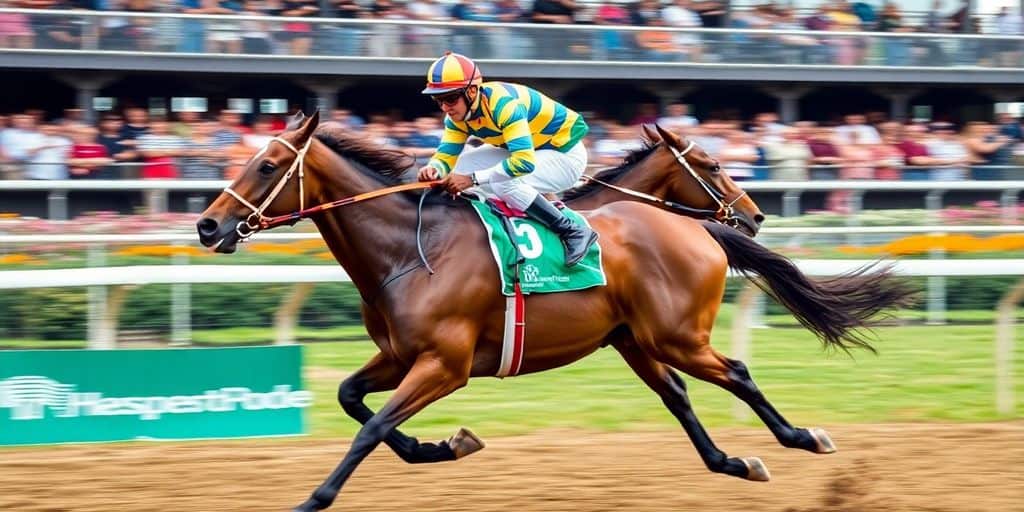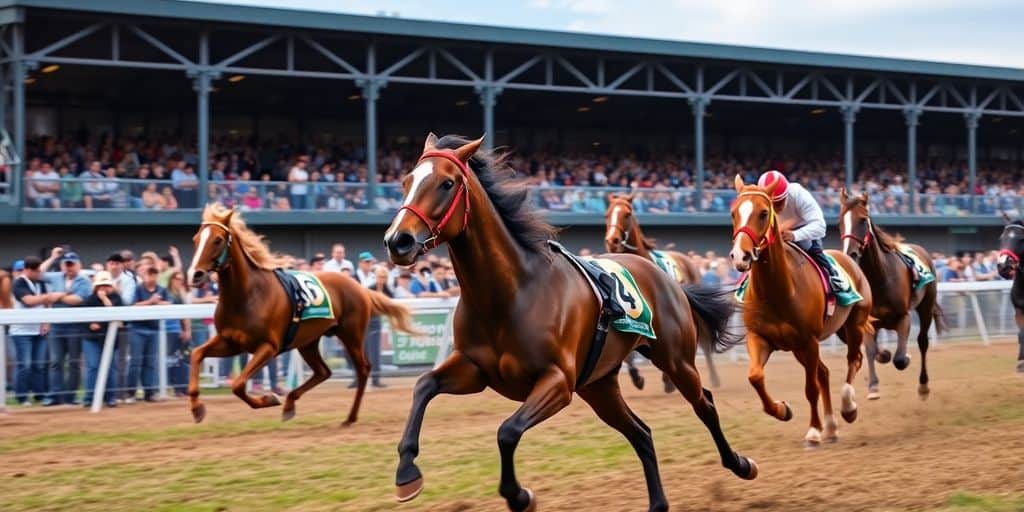Horse racing betting can be thrilling, but it’s not just about luck. Understanding the ins and outs of betting can make a big difference in your success. Whether you’re a newbie or looking to sharpen your skills, this guide will help you navigate the world of horse racing bets in 2025. We’ll cover everything from the basics to advanced strategies, so you can make informed decisions and hopefully come out ahead.
Key Takeaways
- Learn the basics of horse racing and different types of bets.
- Create a personalized betting strategy that suits your style.
- Focus on key factors like speed figures for effective handicapping.
- Stay aware of betting trends and avoid overhyped favorites.
- Keep track of your bets to identify patterns and improve your strategy.
Understanding Horse Racing Bet Fundamentals

The Basics of Horse Racing
Okay, so you want to get into horse racing betting? First, let’s cover the basics. It’s not just about picking a horse with a cool name. You’ve got a bunch of horses running around a track, trying to be the first to cross the finish line. Each horse has a jockey, and they’re all trying to win. Sounds simple, right? Well, there’s more to it. Things like the horse’s past performance, the jockey’s skill, and even the weather can play a big part. Understanding these elements is the first step to online horse racing betting.
Types of Bets Explained
There are a lot of different ways to bet on a horse race. It can be overwhelming at first, but once you get the hang of it, it’s not so bad. Here are a few common ones:
- Win: Your horse has to come in first place.
- Place: Your horse has to come in first or second place.
- Show: Your horse has to come in first, second, or third place.
- Exacta: You have to pick the first two horses in the exact order.
- Trifecta: You have to pick the first three horses in the exact order.
- Superfecta: You have to pick the first four horses in the exact order.
Exactas, trifectas, and superfectas are harder to get right, but they pay out more. It’s all about risk versus reward. You can also find on-course bookies that offer similar odds.
Key Terminology for Bettors
To really get into horse racing, you need to speak the language. Here’s some key terminology:
- Odds: The ratio of payout to stake. For example, 5-1 odds mean you win $5 for every $1 you bet.
- Favorite: The horse that is expected to win. It usually has the lowest odds.
- Longshot: A horse that is not expected to win. It usually has high odds.
- Handicapping: Analyzing a race to predict the outcome.
- Purse: The total amount of money paid out to the winners of a race.
Understanding these terms will help you read articles, listen to commentators, and generally know what’s going on. It’s like learning a new language, but for betting. You can also look at a glossary of racing terms to help you out.
Developing a Winning Betting Strategy
Crafting a Personalized Approach
Okay, so you want to win more bets? It’s not just about picking horses at random. You need a plan, your plan. Think of it like this: you’re building a betting system that fits your style and knowledge. Don’t just copy what everyone else is doing. Be a detective. Look for the angles others miss. Maybe you’re good at spotting horses that do well in the mud, or maybe you have a knack for picking out overhyped favorites. Find what works for you.
Identifying Value Bets
Value bets are where the real money is made. It’s about finding horses whose odds are better than their actual chance of winning. This takes work. You have to do your homework, study the form, and really understand the race. It’s not enough to just pick the favorite. You need to be able to say, "This horse has a 30% chance of winning, but the odds are 5-1, which is a great value." It’s about finding those straight bets that give you an edge.
Avoiding Common Betting Pitfalls
There are traps everywhere in horse racing betting. One of the biggest is chasing losses. You lose a bet, and you immediately try to win it back by betting even more. Bad idea. Another pitfall is betting with your heart instead of your head. Just because you like a horse’s name or the jockey’s colors doesn’t mean it’s a good bet. Stick to your strategy, and don’t let emotions cloud your judgment.
It’s easy to get caught up in the excitement of the race, but the best bettors stay disciplined. They have a plan, they stick to it, and they don’t let emotions dictate their decisions. This is how you turn betting from a hobby into something more profitable.
Here are some common mistakes to avoid:
- Betting on every race.
- Ignoring the data.
- Chasing losses.
- Betting too much of your bankroll on a single race.
The Importance of Handicapping
Handicapping is a big part of horse racing. It’s not just about picking a winner; it’s about understanding why a horse might win. It’s like being a detective, piecing together clues to predict the future. It can feel like deciphering a code, but it doesn’t require a lifetime of experience.
Simplifying the Handicapping Process
Okay, so handicapping can seem overwhelming. There’s so much data! But here’s the thing: you don’t need to know everything. Start simple. Pick one thing to focus on. Maybe it’s speed figures. Get good at understanding that, and then add another element. Think of it like building a house – you start with the foundation, not the roof. Don’t try to decipher every detail to be successful.
- Focus on key factors.
- Master one aspect at a time.
- Gradually add others to your toolkit.
Utilizing Speed Figures Effectively
Speed figures are a common foundation in many strategies. They give you a quick way to compare horses’ past performances. But don’t just look at the numbers. Consider the conditions of the race. Was it a fast track? A slow track? Did the horse have a good start? All of these things can affect a horse’s speed figure. It’s about understanding the context behind the numbers.
Analyzing Race Conditions
Race conditions matter. A lot. Is it a muddy track? Some horses love the mud, others hate it. Is it a long race? Some horses are sprinters, others are stayers. Pay attention to the weather, the track conditions, and the distance of the race. These things can have a big impact on the outcome. It’s about understanding how the handicap race conditions influence race dynamics.
It’s easy to overlook the reasons behind our bets. Not every winning bet is a smart one, and not every losing bet is a bad call. To stay on the winning track, start by jotting down your pre-race reasoning. This simple practice holds you accountable for your choices and helps you avoid hindsight biases.
Maximizing Your Odds
Challenging Overvalued Favorites
Okay, so everyone loves betting on the favorite. It’s like, the obvious choice, right? But here’s the thing: favorites are often overvalued. The odds are shorter than they should be because so many casual bettors are throwing money at them. That means you’re not getting good value for your bet. Think about it – are you really getting a fair return, or are you just paying a premium because everyone else is? It’s smarter to look for horses that are being underestimated by the market.
Recognizing Betting Trends
Betting trends can be super helpful, but you gotta be careful. Just because something happened a bunch of times in the past doesn’t guarantee it’ll happen again. But, if you spot a trend that makes sense – like a certain jockey always does well at a specific track, or a trainer excels with first-time starters – it’s worth considering. Don’t blindly follow trends, but use them as another piece of the puzzle. For example, you might see a trend like this:
| Track | Jockey | Win Rate |
|---|---|---|
| Saratoga | John Velazquez | 22% |
| Belmont | John Velazquez | 18% |
| Aqueduct | John Velazquez | 15% |
This suggests Velazquez performs well at Saratoga. But, you still need to consider the horse, the race conditions, and everything else.
Leveraging Trainer and Jockey Insights
Trainers and jockeys – these are the people who are really in the know. They spend every day with the horses, they understand their quirks, and they know how to get the best out of them. Pay attention to what they’re saying in interviews, read articles about them, and try to figure out which trainers and jockeys are consistently successful. Some trainers are great at getting horses ready for big races, while others are better at developing young talent. Some jockeys have a knack for riding certain types of horses, or for navigating specific tracks. This Kentucky Derby betting guide can help you understand the nuances of the sport.
It’s easy to get caught up in the hype around a particular horse, but don’t forget to do your homework on the trainer and jockey. Their experience and expertise can make a huge difference in the outcome of a race. Look for trainers with a history of success in similar races, and jockeys who have a good rapport with the horse they’re riding.
Here are some things to look for:
- Trainer’s win percentage with first-time starters
- Jockey’s record at the current track
- Trainer/jockey combination success rate
- Recent interviews or articles where they discuss their strategy
Tracking Your Betting Performance
It’s easy to get caught up in the thrill of horse racing, but if you’re serious about improving your betting, you need to track your results. It might seem tedious, but it’s the only way to really see what’s working and what isn’t. Think of it like this: even professional gamblers need to keep tabs on their wins and losses. Let’s get into how to do it effectively.
Recording Your Bets and Outcomes
Start by creating a simple system to record every bet you make. This doesn’t need to be fancy – a spreadsheet works great. Include details like the date, track, race number, horse name, bet type (win, place, show, etc.), stake, odds, and the outcome (win, lose, or place). The more detailed your records, the better you’ll be able to analyze your performance.
Here’s a basic example of how you could structure your tracking:
| Date | Track | Race | Horse | Bet Type | Stake | Odds | Outcome |
|---|---|---|---|---|---|---|---|
| 2025-05-23 | Belmont | 3 | Secretariat | Win | $20 | 2/1 | Win |
| 2025-05-23 | Belmont | 5 | Man o’ War | Place | $15 | 1/1 | Place |
| 2025-05-23 | Belmont | 7 | Citation | Win | $25 | 5/2 | Lose |
Reflecting on Winning and Losing Bets
Don’t just record the data; analyze it. After each race day (or week), take some time to review your bets. Ask yourself why you made those particular bets. What factors influenced your decisions? Did you rely on horse racing statistics, trainer insights, or gut feeling? Understanding the reasoning behind your bets is just as important as knowing the outcome. It’s easy to get caught up in the moment, but reflecting on your choices will help you avoid repeating mistakes.
Identifying Patterns for Improvement
Over time, your betting records will reveal patterns. Maybe you’re consistently successful with certain types of bets or at specific tracks. Perhaps you’re losing money on longshot bets or when you ignore certain handicapping factors. Use these insights to refine your strategy. Here are some things to look for:
- Bet types where you have a high success rate.
- Tracks or race conditions where you perform well.
- Handicapping factors that consistently lead to winning bets.
- Mistakes you repeatedly make.
By tracking your betting performance, you’re essentially creating a feedback loop. This loop allows you to learn from your successes and failures, adapt your strategy, and ultimately improve your chances of winning. It’s a continuous process of learning and refinement.
It’s a journey, not a sprint. Keep at it, and you’ll see improvement over time. Remember to stay disciplined and focus on making informed decisions. Good luck!
Specializing in Specific Race Types
Focusing on High-Quality Races
Some bettors find an edge by focusing on specific race types. It’s like becoming a specialist doctor instead of a general practitioner. High-quality races, like those at prestigious events, often attract horses where every participant is giving their all. This can make the form more reliable and the outcomes more predictable, at least compared to lower-level races where motivation might be questionable.
Understanding Different Horse Types
Different horses excel at different things. A sprinter isn’t going to win a long-distance race, and a stayer won’t have the speed for a sprint. Knowing the difference is key. It’s not just about distance, either. Some horses prefer turf, others dirt. Some like it muddy, others want it firm. Understanding these preferences can give you a leg up. Here’s a few things to consider:
- Sprinters: Short bursts of speed, typically under a mile.
- Milers: Good mix of speed and stamina, ideal for middle distances.
- Stayers: Endurance specialists, excelling at longer distances.
It’s important to remember that specializing takes time and effort. You’re not going to become an expert overnight. But with dedication and a willingness to learn, you can develop a real edge in a specific area of horse racing.
Mastering Niche Betting Strategies
Once you’ve picked a race type or horse type, you can start to develop niche betting strategies. This might involve looking for specific trainer patterns, jockey tendencies, or even weather conditions that favor certain horses. For example, some trainers are known for their success with first-time starters, while others excel at getting horses ready after a layoff. Keeping detailed betting records is essential to identify these patterns. It’s about finding those little edges that others might miss. It’s like having a secret weapon that you can use to your advantage.
Utilizing Data and Statistics

The Role of Data in Betting Success
Data is everywhere these days, and horse racing is no exception. It’s not just about picking a name you like; it’s about digging into the numbers to find an edge. Using data effectively can significantly improve your betting outcomes. Think of it as having a secret weapon that most casual bettors ignore. It’s about time you started using it.
Analyzing Historical Performance
Looking at past races can tell you a lot about a horse’s potential. Here’s what to consider:
- Win Percentage: How often does the horse win?
- Average Finishing Position: Where does the horse typically place?
- Performance on Different Track Conditions: Does the horse do better on dirt or turf?
Historical data provides a foundation for understanding a horse’s capabilities and tendencies. It’s not a guarantee of future performance, but it offers insights that can inform your betting decisions.
Using Technology to Enhance Betting
Technology has changed the game. There are tons of tools out there to help you analyze data and make smarter bets. You can even find course stats by trainer to help you make informed decisions. Here are a few ways to use tech:
- Betting Apps: Many apps offer real-time data and analysis.
- Spreadsheets: Use spreadsheets to track and analyze your own betting performance.
- Specialized Software: Some software is designed specifically for horse racing handicapping.
Here’s a simple example of how you might track your bets in a spreadsheet:
| Date | Race Track | Horse Name | Bet Type | Stake | Odds | Result | Profit/Loss |
|---|---|---|---|---|---|---|---|
| 2025-05-22 | Churchill | Secretariat | Win | $20 | 5/1 | Win | $100 |
| 2025-05-22 | Belmont | Citation | Place | $20 | 2/1 | Place | $40 |
| 2025-05-23 | Pimlico | Man o’ War | Show | $20 | 1/1 | Lose | -$20 |
Wrapping It Up: Your Betting Journey
So, there you have it. Betting on horse races isn’t just about luck; it’s about strategy and a bit of know-how. Sure, it can feel overwhelming at first, but remember, everyone starts somewhere. Focus on what you enjoy, keep track of your bets, and don’t be afraid to dig a little deeper into the details. With time, you’ll find your rhythm and maybe even start seeing some wins. Just take it one race at a time, and who knows? You might just become the next betting pro. Good luck out there!
Frequently Asked Questions
What are the basic types of horse racing bets?
The main types of bets include Win (betting on a horse to finish first), Place (betting on a horse to finish either first or second), and Show (betting on a horse to finish in the top three). There are also more complex bets like Exacta and Trifecta.
How do I develop a successful betting strategy?
To create a good betting strategy, start by understanding your strengths and weaknesses. Focus on specific types of races or horses you know well, and always look for good value in your bets.
What is handicapping and why is it important?
Handicapping is the process of analyzing a horse’s past performances, conditions of the race, and other factors to predict the outcome. It helps bettors make informed decisions and increases their chances of winning.
How can I improve my betting results?
Keep track of your bets and outcomes. Reflect on what worked and what didn’t. Look for patterns in your betting to identify areas for improvement.
Should I follow popular betting trends?
Be cautious with popular trends. Sometimes, betting on favorites can be risky, as their odds may not offer good value. Instead, look for underdogs that have a better chance than what the odds suggest.
What role does data play in horse racing betting?
Data is crucial in betting. It helps you analyze past performances, understand trends, and make better predictions. Using technology and statistics can enhance your betting strategy.











